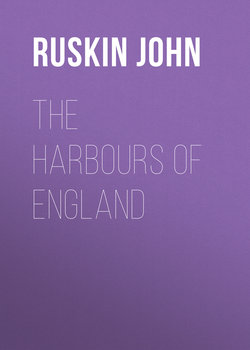The Harbours of England

Реклама. ООО «ЛитРес», ИНН: 7719571260.
Оглавление
Ruskin John. The Harbours of England
EDITOR'S PREFACE
AUTHOR'S ORIGINAL PREFACE
THE HARBORS OF ENGLAND
I.—DOVER
II.—RAMSGATE
III.—PLYMOUTH
IV.—CATWATER
V.—SHEERNESS
VI.—MARGATE
VII.—PORTSMOUTH
VIII.—FALMOUTH
IX.—SIDMOUTH
X.—WHITBY
XI.—DEAL
XII.—SCARBOROUGH
Отрывок из книги
Among the many peculiarities which distinguished the late J. M. W. Turner from other landscape painters, not the least notable, in my apprehension, were his earnest desire to arrange his works in connected groups, and his evident intention, with respect to each drawing, that it should be considered as expressing part of a continuous system of thought. The practical result of this feeling was that he commenced many series of drawings,—and, if any accident interfered with the continuation of the work, hastily concluded them,—under titles representing rather the relation which the executed designs bore to the materials accumulated in his own mind, than the position which they could justifiably claim when contemplated by others. The River Scenery was closed without a single drawing of a rapidly running stream; and the prints of his annual tours were assembled, under the title of the Rivers of France, without including a single illustration either of the Rhone or the Garonne.
The title under which the following plates are now presented to the public, is retained merely out of respect to this habit of Turner's. Under that title he commenced the publication, and executed the vignette for its title-page, intending doubtless to make it worthy of taking rank with, if not far above, the consistent and extensive series of the Southern Coast, executed in his earlier years. But procrastination and accident equally interfered with his purpose. The excellent engraver Mr. Lupton, in co-operation with whom the work was undertaken, was unfortunately also a man of genius, and seems to have been just as capricious as Turner himself in the application of his powers to the matter in hand. Had one of the parties in the arrangement been a mere plodding man of business, the work would have proceeded; but between the two men of talent it came very naturally to a stand. They petted each other by reciprocal indulgence of delay; and at Turner's death, the series, so magnificently announced under the title of the Harbors of England, consisted only of twelve plates, all the less worthy of their high-sounding title in that, while they included illustrations of some of the least important of the watering-places, they did not include any illustration whatever of such harbors of England as Liverpool, Shields, Yarmouth, or Bristol. Such as they were, however, I was requested to undertake their illustration. As the offer was made at a moment when much nonsense, in various forms, was being written about Turner and his works; and among the twelve plates there were four8 which I considered among the very finest that had been executed from his marine subjects, I accepted the trust; partly to prevent the really valuable series of engravings from being treated with injustice, and partly because there were several features in them by which I could render more intelligible some remarks I wished to make on Turner's marine painting in general.
.....
I have given this passage at length, because it seems to me that Dante's most inventive adaptation of the fable of Charon to Heaven has not been regarded with the interest that it really deserves; and because, also, it is a description that should be remembered by every traveler when first he sees the white fork of the felucca sail shining on the Southern Sea. Not that Dante had ever seen such sails;11 his thought was utterly irrespective of the form of canvas in any ship of the period; but it is well to be able to attach this happy image to those felucca sails, as they now float white and soft above the blue glowing of the bays of Adria. Nor are other images wanting in them. Seen far away on the horizon, the Neapolitan felucca has all the aspect of some strange bird stooping out of the air and just striking the water with its claws; while the Venetian, when its painted sails are at full swell in sunshine, is as beautiful as a butterfly with its wings half-closed.12 There is something also in them that might remind us of the variegated and spotted angel wings of Orcagna, only the Venetian sail never looks majestic; it is too quaint and strange, yet with no peacock's pride or vulgar gayety,—nothing of Milton's Dalilah:
That description could only have been written in a time of vulgar women and vulgar vessels. The utmost vanity of dress in a woman of the fourteenth century would have given no image of "sails filled or streamers waving"; nor does the look or action of a really "stately" ship ever suggest any image of the motion of a weak or vain woman. The beauties of the Court of Charles II., and the gilded galleys of the Thames, might fitly be compared; but the pomp of the Venetian fisher-boat is like neither. The sail seems dyed in its fullness by the sunshine, as the rainbow dyes a cloud; the rich stains upon it fade and reappear, as its folds swell or fall; worn with the Adrian storms, its rough woof has a kind of noble dimness upon it, and its colors seem as grave, inherent, and free from vanity as the spots of the leopard, or veins of the seashell.
.....